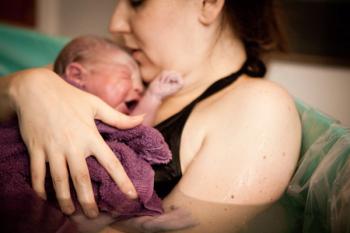Findings in Brief
In contrast to the pattern seen with singleton births, twins born to older mothers do not appear to have a greater risk of birth complications than do twins born to younger mothers, according to a recent study by researchers at the National Institute of Child Health and Human Development (NICHD) and the University of Kansas. The study also found that triplets born to older mothers actually fare better than triplets born to younger mothers.
Implications
Twin and triplet pregnancies
Study Publication
Fertility and Sterility
Reason for the Study
To examine the risks to children born from twin and triplet pregnancies in older women. These risks included very preterm birth (birth at less than 33 weeks gestation), very low birthweight (less than 1,500 grams), perinatal death (death occurring between 24 weeks gestation and six days after birth), and infant death (death occurring between six days and one year after birth).
Director's Comments
"Twin and triplet pregnancies are generally riskier for both mothers and infants than are singleton pregnancies,” said Duane Alexander, M.D., Director of the NICHD. “However, this study is encouraging because it indicates that twins and triplets born to older mothers do not have any greater risk of poor birth outcomes than do those born to younger mothers.”
Background
In the last two decades, the increased use of fertility drugs and assisted reproductive technology (ART) have resulted in an increase in the number of twin and triplet pregnancies in women over the age of 35. Although several previous studies have shown that older maternal age is associated with an increased risk of premature birth, low birth weight, and death in singleton pregnancies, few studies have looked at the effect of maternal age on birth outcomes in twin and triplet pregnancies.
Study Details
Jun Zhang, Ph.D., M.D., and colleagues, analyzed data from 147,400 twin pregnancies and 5,015 triplet pregnancies using the National Center for Health Statistics’ (NCHS) Matched Multiple Birth File. This national database contains linked birth and death certificates from multiple gestation pregnancies that occurred between 1995 and 1997 in the United States. They also examined data from 3,775,974 single pregnancies using the NCHS 1996 Linked Birth/Infant Death file and the 1996 National Fetal Death File.
Findings in Depth
Compared to women with singleton pregnancies, women with twin and triplet pregnancies were more likely to be older, non-Hispanic white, better educated, married, pregnant for the first time, and to have started prenatal care earlier. After accounting for maternal race, number of pregnancies, education, marital status, time of first prenatal visit, and smoking during pregnancy, the researchers found that among single born infants, the risk of suffering from poor birth outcomes increased as the age of the mother increased. However, this relationship almost disappeared among twins, and showed a reverse pattern for triplets. In fact, triplets born to older mothers were actually less likely to experience poor birth outcomes than were triplets born to younger mothers. However, when the researchers analyzed data from a smaller group of women who were unmarried and had no college education (a group known to be less likely to conceive using ART), they found that the risk of very preterm birth, very low birthweight, and perinatal death, increased as maternal age increased.
Author's Comments
According to Dr. Zhang, the first author of the study and a researcher with the NICHD’s Division of Epidemiology, Statistics, and Prevention Research, there are several differences between multiple gestation pregnancies achieved through the use of ART and those achieved naturally. “Twins and triplets born through the use of ART are less likely than twins and triplets conceived naturally to share a placenta or amniotic sac. This reduces their risk of suffering from such complications as twin-to-twin transfusion syndrome, which can lead to poor birth outcomes,” he said. “Additionally, women who achieve multiple gestation pregnancies through the use of ART are more likely to receive good prenatal care, and their infants are likely to receive better care as newborns than are multiples born to women who did not conceive through the use of ART.” According to the authors of the study, many pregnancies achieved through the use of ART, especially those among older women, involve the use of donor eggs. Most donor eggs come from younger women, so many older women with twin and triplet pregnancies are actually carrying children conceived from younger eggs. Finally, the authors speculate that women who use ART are better off financially than are women who conceive naturally. As a result, they may have better health care coverage and lower physical stress during pregnancy. “Multiple gestation pregnancies are riskier than singleton pregnancies at any age and under any care,” said Dr. Zhang. “But this study shows us that clinical practice can alter the natural pattern of risk.”
Study Strengths
The study used national data from all singleton pregnancies delivered at 24 weeks of gestation or later in 1996 and all twin and triplet pregnancies delivered at 24 weeks of gestation or later between 1995 and 1997. By examining data from the entire population, the researchers eliminated selection bias, which is a phenomenon that sometimes occurs when data taken from a sample of the population differ from data observed in the population as a whole. Using data from the entire population also allowed for a large sample size.
Study Limitations
The data used by the researchers did not indicate whether pregnancies were achieved naturally or through the use of ART. However, the authors speculated that many of the twin and triplet pregnancies, particularly those in older women, were conceived through the use of fertility treatments. This assumption is supported by research that shows that the proportion of twin pregnancies achieved using ART increases from less than five percent in women in their late 20s to over 40 percent in women over 40 years of age. In triplet pregnancies, the proportion increases from 40 percent to over 80 percent.
References:
The NICHD is part of the National Institutes of Health, the biomedical research arm of the federal government. The Institute sponsors research on development, before and after birth; maternal, child, and family health; reproductive biology and population issues; and medical rehabilitation. NICHD publications, as well as information about the Institute, are available from the NICHD Web site, http://www.nichd.nih.gov, or from the NICHD Clearinghouse, 1-800-370-2943; e-mail NICHDClearinghouse@mail.nih.gov.
















